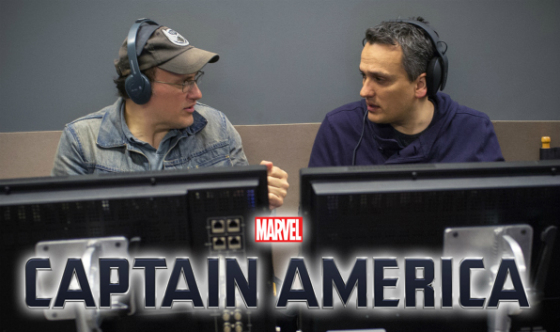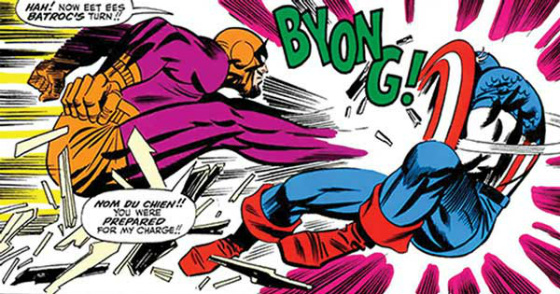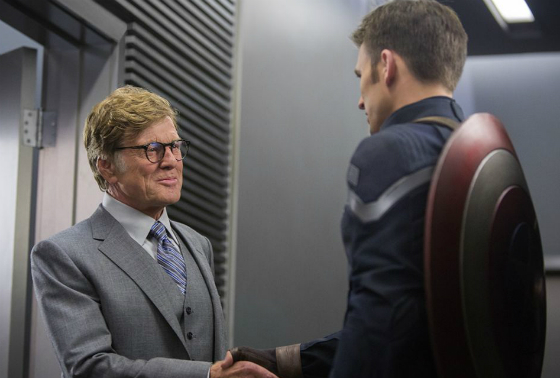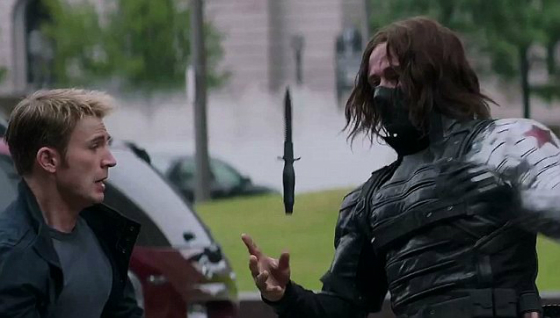SPOILERS! Captain America Directors Talk 9-11, Costume Changes and THAT Ending.
 |
Though they may be best known for their TV work with shows like Community and Arrested Development, you’d never guess from seeing Captain America: The Winter Soldier that Joe & Anthony Russo were anything but cinematic through and through. It’s too early for me to give specific thoughts on the movie…and yet they had no compunction whatsoever about discussing things in some detail that other directors might be more coy about.
So be warned…there be potential spoilers ahead.
Luke Y. Thompson: When I first saw the image of Captain America in costume, initially, I was like, “Damn. There’s no red.” But now that I’ve seen it, it’s like, maybe it’s because he’s not really fighting for the red, white, and blue in the beginning.
Anthony & Joe Russo: Yeah.
Joe Russo: That is the concept. You don’t want to blow the movie for people, and I remember when it first came online and everybody was complaining about it. You know, there’s a metaphorical arc to the use of this costume in this film. In the beginning of the movie, he’s working as a special operative for a covert organization, so he’s wearing a functional uniform that gives him the ability to attack a ship at night, and move around fairly – without a target on his chest. He doesn’t function as a symbol of the country at that point. He’s functioning as a covert operative.
Anthony Russo: Mm-hmm.
JR: Later in the film, he realizes how important it is that he puts the symbol back on and re-embraces the symbolism of the outfit. And so, hopefully people will be – as you were…
AR: Understanding how the uniform was being used – as a narrative tie. Yeah.
 |
LYT: In terms of costumes, Marvel is often quite faithful to them, but you, in the script, were landed with two of the more ridiculous ones, in Batroc the Leaper and the Falcon.
JR: Yeah.
LYT: Was there ever a point at which you tried to make the originals work in any way, or did you just say, “No”?
[Both]: No.
JR: As a comic book fan, I’ve been collecting since I was 10, and I’m a big Marvel guy. I mean, I collected a lot of Marvel comics, and I always hated the Falcon’s outfit when I was a kid. I thought it was ridiculously dated. I didn’t like his back story either. I thought it was very stereotypical.
AR: Yeah.
JR: And Batroc’s outfit is absurd. But we found elements of it that we could pull into the sort of grounded universe that we were trying to build, for this thriller that we were making. Batroc basically is a mercenary or terrorist in the film, so we were able to take some of the purple from the outfit, and find a way to make the outfit still look functional without being ridiculous.
 |
LYT: From sort of the get-go on this, ’70s political thriller has been kind of the buzz phrase. Was that you’re idea from the get-go, or was that something sort of…?
JR: I think it was Kevin [Feige] and Marvel’s idea.
AR: It pre-existed us.
JR: It pre-existed our involvement in the movie, but it’s the reason we loved the idea of the film. It’s a double-whammy: comic book collectors, so we’re comic book nuts, so somebody is offering us a comic book movie, and we grew up watching ’70s thrillers. That’s how we got interested in film. Our father was a big – he loved genre movies, and we used to watch the late show with him every night. Black Friday, French Connection, All the President’s Men, 3 Days of the Condor – we grew up on those films. So when they said that they wanted to use that as an influence, we said, “Look, if that’s-we were born to direct this movie.”
LYT: Was the casting of Robert Redford presumably a direct nod to that?
JR: It was. It was very-you know, this movie, we’ve joked that you could call this movie 3 Days of Captain America, because it owes a huge debt, creatively, to 3 Days of the Condor, structurally. And to get Redford to us was just, for us – one, not just as a brilliant actor and brilliant screen presence, but two, philosophically, there was a continuity between the last time we had great political thrillers and our movie.
 |
LYT: Of course, you’ve never had a ’70s political thriller that was in 3-D – were you trying for the look of a thriller as well as the tone? If so, how does 3-D affect that?
JR: We were.
AR: It does affect that, interestingly. We went for a verite camera style, which is hand-held, makes you feel like you’re there. There’s an imperfection to the framing, in its relationship to the action. That sort of like…
JR: Look-we shot the movie in 2-D. For us it’s about the cinema of the movie, how the movie’s going to live. It will live in 2-D on your DVD and then the Apple Television, or wherever it exists. It does complicate-the hand-held does complicate 3-D, because it can make you-it can make it a little jumpy.
AR: We worried a lot in terms of how we would size of the 3-D.
JR: We worked real hard to massage that. The third act, though, is exquisite in 3-D.
AR: Yeah.
JR: It’s got this – it’s more of an adventure film, and you’re dealing with these big-scale – the shots are a little more premeditated and fluid.
LYT: I’m sure with the third act, you had this conversation – I don’t think I’m spoiling anything, because we’ve seen an aircraft crash in one of the trailers – did you have a conversation about aircraft crashing into buildings? Is that something people will still consider escapist? Because I was surprised at how well it didn’t bother me.
AR: Yeah. Absolutely.
 |
JR: We had that conversation, at least a thousand times, because it’s something that we’re very sensitive to, as film makers…
AR: And as people!
JR: Well, yeah-about representing something that is not, like you said, escapist or in any way disrespectful. You don’t want to take people out of the movie.
LYT: Yeah.
JR: There’s a grounding element to the film, which is important, but it ultimately is a super hero movie, and if you smack them in the face…
AR: With that…
JR: …with, you know, images that remind them of a horrific point in our history, you’re pulling them out of the movie.
AR: We liked the idea of physically destroying SHIELD, though…
JR: Which is a metaphor…
AR:…yeah. And we thought that, as long-we just had a mandate to everybody, which we discussed, which was like, “Stay away from being evocative of 9-11 in any way.” Yes, we were wrecking a building, but we don’t – where you’re on a textural level, you make choices that aren’t in that world, you know.
LYT: I was having a discussion with one of my fellow journalists , and he was like, “Well, the right wing is going to go nuts over this.” And I was like, “No, the left wing is going to go nuts over this.” The right wing is going to say it’s Obama, and the left wing is going to say it’s Bush. How careful were you to balance how people could take it either way?
JR: What I think is so funny about that is that we had that same conversation while we were making the movie. And really, the world did that for us. We didn’t have to balance it. We had a Democrat in office who has a kill list, who uses drone technology to do preemptive strikes, where innocent bystanders are being killed, while we’re also taking out terrorists, or suspected terrorists, I should say, which is just a legacy of what people often identify as a Republican point-of-view. So now it’s no longer germane to either party – it belongs to both parties. So yes, I think any pundit could use the message of this movie to service either side of the line.
 |
LYT: On a much lighter note than that: often when you have masked superheroes in movies, they end up taking their mask off as much as possible. There are fanboy theories – one would assume that’s just because you want to see the emotion on the actor’s face, but there are fanboy theories that some actors have it in their contract that they have to have their face show a certain percentage of the time. True or false on that?
JR: That’s false.
AR: I’ve never heard of that.
JR: On our movie, that’s false. I know that. It is, a lot of it is about emotion and connecting to the character on a human level. And sometimes if you need a scene to play out between – an emotional scene to play out between that hero and another character, it’s very difficult to get that emotion when you can’t see their eyes, you can’t see their facial expression. For us, it’s the only reason we would ever have Cap out of his mask.
LYT: I was reading in the press kit that it said you guys had a great time shooting in Cleveland, but you shut down the major freeway. So does Cleveland still love you guys as much as you love it, because of shutting down their traffic?
AR: That’s a good question.
JR: We would hope so.
AR: I’ll say this: we are planning to have a really exciting premiere there in a few weeks! Listen, we love this city, and we had an awesome time shooting there. This is the second Marvel movie that shot there. Avengers also shot there. So the city is in a great place for shooting right now. And look – we want – we’re really grateful that we were given that as a resource to make this movie. It was phenomenal! So we’ll see. We’ll have to just see. I mean, it depends where you live in the city. If that wasn’t your freeway, you have no problems with us.
LYT: Does Quentin Tarantino know about the little Easter egg?
AR: Not that we know.
JR: Not that we know. And that was something that actually came in at the last second. We were struggling. We probably did 10 iterations of what…epitaph should be on that gravestone, and I think we were sitting in the VFX review, and I think it was our – I think it was Dan Deleeuw, the effects supervisor who came up with the idea.
AR: But we love Easter eggs, so we always would prefer to make the choice to put in an Easter egg, rather than to put in something that lacks multiple layers of appreciation.
 |
LYT: Are there more little things in there that maybe we should be looking out for, maybe the second time?
JR: There’s a lot. There’s a lot. I mean, we put in a lot of Easter eggs in the movie. They’re like titles of books that are on Cap’s bookshelf that are Easter eggs. There’s contents in Redford’s refrigerator that are Easter eggs.
LYT: The Newman’s Own dressing.
AR: Exactly. [chuckles]
JR: So there’s lots of little jokes. We always encourage our prop department and our crew and our design team to look for ways to bury those in the movie.
LYT: Without spoiling any details, the Winter Soldier story line still has some loose ends at the end. Are those leading into Age of Ultron, or are they leading into another Captain America movie, as far as you know?
AR: You know, the condition that SHIELD is in at the end of this movie, leads it to Age of Ultron. The conditions of the relationship between Captain America and Winter Soldier are very much about the next Captain America.
JR: And you know, Frank Grillo’s character, Brock Rumlow – there’s the potential that this is now the origin story for him-that Crossbones will emerge.
LYT: Did you have to coordinate with the Agents of SHIELD TV show at all, because obviously this is going to affect that in a very major way, and I’m waiting for the TV continuity to catch up, just so I can see how?
JR: They, you know-listen, you know, there’s a funny story. They all came to watch the movie for the first time, and none of them knew what was going to happen in the film, and I think they were all looking at each other a little stunned at the end of the movie. But there was coordination-I’m talking about the actors on the show. There was coordination between Kevin [Feige] and Jed [Whedon] and Kevin is really the linchpin for all of that.
LYT: Are you guys doing another one after this?
JR: We are. We’re hard at work on Cap 3 already. As you can tell from the movie, there’s a bit of an emotional cliffhanger.
LYT: Yes.
JR: Winter Soldier’s story is not complete, and it certainly begs a follow-up film.
Subsequent to this interview, it was announced that Captain America 3 will open on the same date as Batman vs. Superman.

